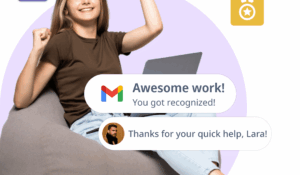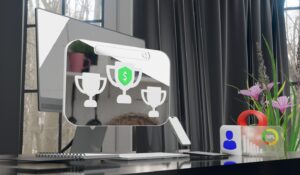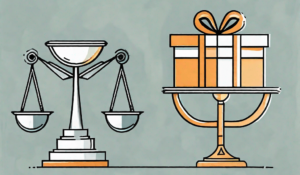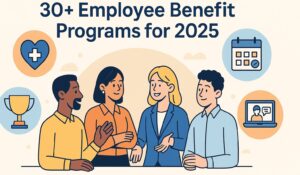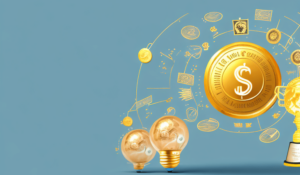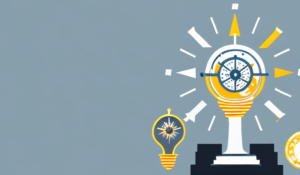Creating a workplace where employees feel valued starts with implementing effective employee rewards and recognition ideas. Organizations that prioritize acknowledgment of employee contributions see higher engagement and retention. This guide explores practical employee reward ideas, recognition strategies, and employee recognition best practices that can help transform your workplace into a thriving environment where employees feel motivated and supported.
What are Rewards and What is Recognition?
Rewards refer to tangible or monetary benefits provided to employees as acknowledgment for their achievements, contributions, or milestones. These typically include bonuses, gift cards, promotions, salary increases, and additional benefits that hold financial value. They serve as direct incentives that encourage employees to maintain high performance.
Recognition, on the other hand, focuses on public acknowledgment and appreciation of employees’ efforts, accomplishments, and behaviors that align with organizational values. Unlike employee rewards, recognition is often non-monetary and comes in forms such as verbal praise, certificates, trophies, or public announcements. It helps foster a sense of belonging and motivation among employees.
Both rewarding employees and recognition initiatives play a crucial role in maintaining employee morale and productivity. When implemented thoughtfully, these programs can significantly impact organizational success. By creating a culture where employees feel appreciated and motivated, companies can drive engagement and inspire consistent high performance.

Key Takeaways
- Unique employee reward ideas keep staff motivated and appreciated.
- Monetary and non-monetary rewards both play a crucial role in recognition.
- Personalized, timely, and inclusive recognition creates lasting impact.
- A well-planned recognition program drives engagement, loyalty, and performance.
Understanding the Distinctions Between Rewards and Recognition
Although employee reward ideas and recognition ideas are frequently mentioned together, understanding their differences is vital for implementing effective programs. Here’s a quick breakdown:
| Rewards | Recognition |
|---|---|
| Tangible and often monetary | Typically intangible and emotionally driven |
| Usually private | Generally public |
| Focused on outcomes and results | Acknowledges efforts and behaviors |
| Formal and structured | Can be formal or informal |
| Scheduled (monthly, quarterly, yearly) | Often spontaneous and immediate |
Effective employee recognition strategies incorporate both approaches. Some staff may value public recognition above monetary benefits, while others prefer tangible rewards that acknowledge their contributions.
👉 Learn more about strategic technology that supports recognition in our guide on employee recognition software.
30 Creative Ideas for Employee Rewards and Recognition
When implementing employee recognition ideas, using the right employee recognition software can streamline the process and make recognition more impactful. Here are thirty proven and innovative employee reward ideas and recognition approaches:
Monthly Ideas for Recognizing Employee Performance
- Spotlight Employee – Feature top performers in company newsletters or intranet platforms.
- Flexible Work Hours – Offer flexible scheduling for outstanding performance.
- Professional Development Allowance – Provide a budget for courses or workshops.
- Peer-to-Peer Recognition Platform – Implement an employee recognition platform where colleagues can acknowledge each other easily.
- Appreciation Lunches – Host meals for teams that exceed targets.
- Wellness Benefits – Offer fitness subscriptions or wellness memberships.
- Work Anniversary Celebrations – Acknowledge milestones with personalized gifts.
- Extra PTO Day – Award additional time off for exceptional work.
- Parking Spot Privilege – Reserve prime parking locations for top performers.
- Skills Showcase – Create opportunities for employees to share expertise.
Quarterly Recognition Strategies
- Achievement Trophies – Present physical awards for performance.
- Experience-Based Rewards – Offer tickets to events or unique experiences.
- Team Celebration Events – Organize team-building activities.
- Professional Photo Sessions – Provide updated professional headshots.
- Charitable Donation Matching – Match employee donations to causes.
- Innovation Grants – Fund small projects proposed by creative staff.
- Cross-Departmental Shadowing – Enable learning from other departments.
- Personalized Tech Upgrades – Provide new equipment or tools.
- Workplace Improvement Budget – Let teams enhance their own spaces.
- Recognition Wall – Create digital or physical displays highlighting wins.
Annual Recognition Practices
- Leadership Retreats – Invite top performers to planning sessions.
- Company-Wide Awards Ceremony – Celebrate achievements at formal events.
- Sabbatical Programs – Offer extended leave after tenure milestones.
- Education Reimbursement – Cover advanced degree or certification costs.
- Travel Opportunities – Provide vacation packages or vouchers.
- Stock Options – Award shares for long-term commitment.
- Custom Career Pathing – Personalize employee development plans.
- Home Office Stipend – Support remote work setups.
- Family Celebration Packages – Recognize achievements by including families.
- Legacy Projects – Allow employees to lead passion projects.
The Impact of Employee Rewards and Recognition on Engagement
Effective employee recognition best practices lead to measurable results:
- Retention: Valued employees are 56% less likely to leave.
- Productivity: Teams with recognition programs see significant gains in performance, with Gallup research showing higher productivity among engaged teams.
- Engagement: According to Great Place to Work, 37% of respondents said more personal recognition would improve their performance.
- Team Cohesion: Peer recognition strengthens workplace bonds.
- Customer Service: Recognized employees deliver better experiences.
- Innovation: Acknowledging creative thinking encourages new ideas.
👉 See how structured programs can support these outcomes with employee recognition platforms.
Exploring Various Types of Employee Rewards
Effective employee rewards incorporate multiple approaches:
- Monetary Rewards: Bonuses, profit-sharing, spot awards, referral incentives. (Learn about monetary benefits)
- Non-Monetary Rewards: Gift cards, branded merchandise, subscription services.
- Experience-Based Rewards: Travel vouchers, event tickets, wellness retreats.
- Professional Development Rewards: Training, certifications, conference passes.
- Work-Life Balance Rewards: PTO, flexibility, sabbaticals, family support.
👉 For more on choosing the right approach, explore intrinsic vs extrinsic rewards.
Effective Utilization of Employee Recognition Strategies
For recognition programs to achieve maximum impact:
- Align with company values.
- Personalize recognition.
- Deliver recognition promptly.
- Ensure consistency and fairness.
- Communicate criteria transparently.
- Make recognition inclusive.
- Track and measure effectiveness.
- Keep programs financially sustainable.
- Update regularly based on feedback.
- Integrate with modern recognition software.
👉 To design a full program, explore employee reward systems.
How HubEngage Simplifies Rewards and Recognition
When implementing ways to reward employees, using the right technology makes all the difference. HubEngage’s Employee Recognition Platform unifies recognition approaches and automates administration, from peer-to-peer shout-outs to milestone tracking.
Key Benefits:
- Social Recognition Wall and Peer-to-Peer Recognition features.
- Points-Based Reward System with gamification.
- Multi-Channel Accessibility (mobile, desktop, email, slack, teams, digital signage).
- Advanced Analytics for measuring ROI.
- Customizable Workflows and branding.
👉 See all features and learn more about our employee recognition software platform.
Designing an Effective Recognition Strategy
Building a recognition strategy requires more than picking a few reward ideas—it should be a structured process that connects directly to business goals. The four key phases include:
- Assessment: Gather input from employees, evaluate current recognition practices, and identify gaps in engagement or motivation.
- Design: Define clear objectives, establish criteria for recognition, and decide on the mix of rewards (monetary, non-monetary, experiential).
- Implementation: Roll out the program through multiple channels, train managers and leaders to recognize effectively, and communicate the program so all employees understand how it works.
- Evaluation: Measure participation, survey employees, analyze retention and performance data, and continuously refine the program.
By following these phases, organizations ensure that recognition programs are sustainable, inclusive, and aligned with long-term business outcomes.
Example in Practice
- Assessment: A mid-sized tech company surveys its workforce and finds that younger employees crave more frequent, informal recognition while senior staff want clear career development rewards.
- Design: Leadership creates a framework with spot awards for day-to-day wins and a structured quarterly recognition program tied to company values.
- Implementation: The company rolls out a digital recognition platform, trains managers on giving timely feedback, and launches peer-to-peer shout-outs.
- Evaluation: HR reviews quarterly analytics, tracks participation, and adjusts the program based on feedback—for example, adding wellness-related rewards after employee input.
This practical approach helps organizations see how each phase translates into action and measurable impact.
Best Practices for Long-Term Program Success
Sustaining an employee recognition program over the long term requires careful attention. Many initiatives start strong but fade within the first year—studies from SHRM suggest that nearly 40% of recognition programs fail to deliver consistent impact because they aren’t refreshed or measured. To avoid this, organizations should treat recognition as an evolving practice, not a one‑time rollout. Programs that adapt and involve leadership are proven to deliver higher engagement and retention.
- Refresh reward offerings.
- Manage budgets effectively.
- Streamline administration.
- Promote consistently.
- Engage leadership and managers.
- Gather ongoing feedback.
- Use recognition data to evolve programs.
👉 Want award-specific ideas? Explore creative employee award examples.
Recognition Across Different Workforce Generations
Generational differences have a big influence on how employees want to be recognized, and overlooking them can cause recognition programs to fall flat. Research shows that younger employees often disengage when feedback is infrequent, while older employees may value stability and financial security more. Recognizing these nuances is crucial for inclusivity and effectiveness.
For example, Gen Z prefers immediate, tech-driven recognition through mobile apps, social feeds, or gamified shout-outs. Millennials value a mix of public praise, professional development opportunities, and experiences. Gen X often responds to financial rewards, autonomy, and career advancement recognition. Baby Boomers may appreciate more formal acknowledgments, tenure awards, and legacy-building opportunities.
By tailoring recognition strategies to each generation, organizations not only make employees feel seen and valued, but also build a culture where everyone is motivated in ways that matter most to them. In fact, a Deloitte study found that companies with inclusive recognition programs are 31% more likely to see stronger financial results and improved engagement. Likewise, Gallup research highlights that employees who receive recognition at least once a week are nearly 5x more likely to feel connected to their workplace. These statistics reinforce why adapting recognition across generations is not just thoughtful—it directly impacts performance and retention.
Future Trends in Employee Recognition
- AI-driven recognition opportunities.
- Hyper-personalized employee rewards.
- Wellness-focused programs.
- Real-time micro-feedback.
- ESG-aligned recognition.
Closing Thoughts: Transforming Culture Through Recognition
Recognizing and rewarding employees is essential for building a thriving workplace. Combining monetary and non-monetary recognition creates balance and strengthens motivation. Structured programs supported by modern platforms ensure employees feel valued consistently.
At HubEngage, we simplify recognition with an all-in-one platform that automates rewards, fosters engagement, and strengthens company culture.
👉 Take a free demo today and see how effortless recognition can be. By consistently recognizing employee performance and contributions, and applying the right employee reward ideas and employee recognition ideas, you can transform workplace culture and drive long-term success.
FAQs
What is the difference between employee rewards and employee recognition?
Rewards are tangible, often monetary incentives such as bonuses, gift cards, or extra time off. Recognition is the act of appreciating employees’ efforts, often non-monetary, such as verbal praise or public acknowledgment.
What are the best ways to reward employees without money?
Non-monetary rewards include flexible schedules, wellness programs, professional development opportunities, public praise, additional vacation days, or team celebrations.
How can companies measure the success of employee recognition strategies?
Organizations can track participation rates, employee surveys, retention data, and productivity metrics. Recognition software also provides analytics for measuring program impact. 👉 Explore our guide to employee recognition software [LINK] for more.
How often should employees be recognized?
Recognition should be consistent and timely. Day-to-day shout-outs, monthly spotlights, quarterly awards, and annual ceremonies ensure employees feel appreciated regularly.
What role does employee recognition software play in modern programs?
Employee recognition platforms streamline processes, enable peer-to-peer appreciation, gamify recognition with points systems, and provide data-driven insights to improve program effectiveness.
What are some creative employee recognition ideas?
Examples include spotlighting employees on digital signage, granting extra PTO, hosting team-building events, supporting charitable donations, or offering career development stipends.
Are employee recognition programs important for retention?
Yes. Recognition programs directly impact employee engagement and retention. Studies show valued employees are significantly less likely to leave, which saves on hiring costs and preserves culture.
What are employee recognition strategies?
Employee recognition strategies are structured approaches to consistently acknowledging employee performance and contributions. They include defining criteria, making recognition timely and inclusive, and integrating tools like recognition software to ensure scalability.


